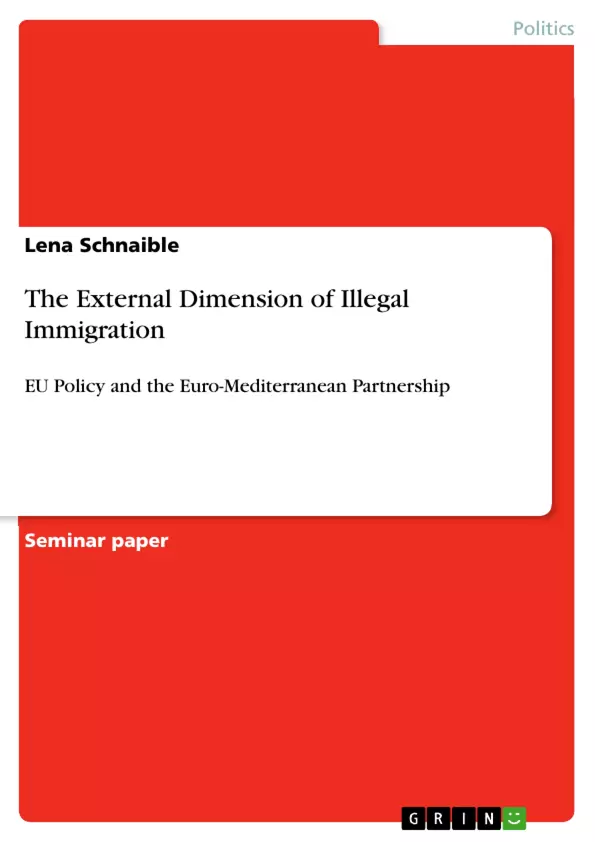On the 13th of March 2008 the EU-Council in Brussels decided the formation of a Mediterranean Union, which shall deepen the relations to the south and east Mediterranean states. This Union shall intensify the Euro-Mediterranean Partnership launched in 1995 in Barcelona. The Euro-Mediterranean Partnership includes political and security dialogues, the gradual establishment of a free trade area and cultural relations under the framework of the European Neighbourhood Policy (ENP) of the EU. The bilateral and multilateral agreements are mentioning as well topics such as migration and asylum. These subjects are today more than ever important for EU member states. The EU is for many migrants the possibility to escape the bad living conditions in their home countries, which are to a huge degree countries of the south and east Mediterranean. Due to this problem, EU member states decided to manage legal and illegal immigration as well as the flow of refugees on the multilateral level of the EU.
Since the Treaty of Amsterdam this area is located in the first pillar of the EU and not longer in the intergovernmental third pillar. As it can be seen in the bilateral and multilateral agreements of the EU with non-EU members there is definitively an EU foreign policy dimension of migration and asylum. Since migration is evidentially a timeless topic and the creation of a Mediterranean Union was decided currently, this paper will analyze the external dimension of illegal immigration in the relations with the Mediterranean partner countries. Which approach is the EU following regarding illegal immigration in general? How far are the Euro-Mediterranean Partnership states included in the management of illegal immigration? Which strategies include the agreements with these countries? Where might be problems of the EU-management of illegal immigration in the cooperation with the countries of the Mediterranean? These shall be the key-questions the paper will answer.
Inhaltsverzeichnis (Table of Contents)
- Introduction
- Illegal Immigration Policy in the EU – connecting the internal and the external
- Cooperation with third countries
- Strengthening the external borders
- The fight against human trafficking
- Tackling illegal employment
- Return Policy
- Improved information exchange
- The Euro-Mediterranean Partnership: two parties one thread?
- Problems and criticism of the EU policy towards illegal migration
Zielsetzung und Themenschwerpunkte (Objectives and Key Themes)
This paper examines the external dimension of illegal immigration in the European Union's (EU) relationship with Mediterranean partner countries. It analyzes the EU's overall approach to managing illegal immigration and assesses the role of the Euro-Mediterranean Partnership in this process. The paper seeks to understand how the EU's foreign policy objectives on immigration interact with the Partnership framework. Key themes explored include: * The EU's policy framework on illegal immigration, including its focus on cooperation with third countries, border strengthening, and combating human trafficking. * The intersection of the EU's immigration policies with the objectives and strategies of the Euro-Mediterranean Partnership. * Challenges and criticisms associated with the EU's management of illegal immigration, particularly in its relations with Mediterranean countries.Zusammenfassung der Kapitel (Chapter Summaries)
Introduction
This chapter establishes the context for the paper by outlining the formation of the Mediterranean Union in 2008, which seeks to deepen the relationship between the EU and the Mediterranean region through the Euro-Mediterranean Partnership. The chapter emphasizes the importance of migration and asylum for EU member states and highlights the need for managing both legal and illegal immigration.Illegal Immigration Policy in the EU – connecting the internal and the external
This chapter provides a detailed overview of the EU's policy on illegal immigration. It discusses the shift from a "fortress Europe" approach to a more comprehensive migration management strategy that includes cooperation with third countries, border strengthening, and combating human trafficking. The chapter also explores the historical evolution of the EU's approach to migration, highlighting the transition from intergovernmental to supranational management and the increasing emphasis on security considerations.Cooperation with third countries
This chapter focuses on the crucial role of cooperation with third states, particularly those of origin and transit, in the fight against illegal immigration. The EU aims to support these countries in developing their own migration management systems, encompassing a broad range of aspects, including refugee protection, prevention of illegal immigration, promotion of legal migration pathways, and border control capacity building.Strengthening the external borders
This chapter addresses the EU's commitment to strengthening external border controls, highlighting the establishment of the European Agency for the Management of Operational Cooperation at the External Borders (FRONTEX) in 2005. The chapter details FRONTEX's responsibilities, including coordinating external border controls, training border guard instructors, facilitating the return of illegal immigrants, and developing a network of Mediterranean coastal patrols in collaboration with third states.Schlüsselwörter (Keywords)
The primary keywords and focus topics of this text are: illegal immigration, EU policy, Euro-Mediterranean Partnership, external dimension, cooperation with third countries, border strengthening, human trafficking, return policy, development policy, security policy, migration management, and refugee protection. These concepts underscore the complex and multifaceted nature of the EU's approach to managing illegal immigration in the context of its relationships with Mediterranean partner countries.- Citar trabajo
- Lena Schnaible (Autor), 2008, The External Dimension of Illegal Immigration, Múnich, GRIN Verlag, https://www.grin.com/document/137898



